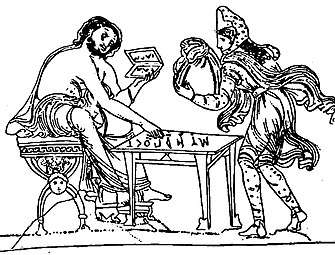Sand table
A sand table uses constrained sand for modelling or educational purposes. The original version of a sand table may be the abax used by early Greek students. In the modern era, one common use for a sand table is to make terrain models for military planning and wargaming.

Abax
An abax was a table covered with sand commonly used by students, particularly in Greece, to perform studies such as writing, geometry, and calculations.[2]
An abax was the predecessor to the abacus. Objects, such as stones, were added for counting and then columns for place-valued arithmetic. The demarcation between an abax and an abacus seems to be poorly defined in history;[3] moreover, modern definitions of the word abacus universally describe it as a frame with rods and beads[4] and, in general, do not include the definition of "sand table".
The sand table may well have been the predecessor to some board games. ("The word abax, or abacus, is used both for the reckoning-board with its counters and the play-board with its pieces, ...").[5] Abax is from the old Greek for "sand table".[6]
Ghubar
An Arabic word for sand (or dust) is ghubar (or gubar), and Western numerals (the decimal digits 0–9) are derived from the style of digits written on ghubar tables in North-West Africa and Iberia, also described as the 'West Arabic' or 'gubar' style.[7]
Military use

Sand tables have been used for military planning and wargaming for many years as a field expedient, small-scale map, and in training for military actions. In 1890 a Sand table room was built at the Royal Military College of Canada for use in teaching cadets military tactics; this replaced the old sand table room in a pre-college building, in which the weight of the sand had damaged the floor.[8] The use of sand tables increasingly fell out of favour with improved maps, aerial and satellite photography, and later, with digital terrain simulations. More modern sand tables have incorporated Augmented Reality, such as the Augmented Reality Sandtable (ARES) developed by the Army Research Laboratory.[9] Today, virtual and conventional sand tables are used in operations training.
In 1991, "Special Forces teams discovered an elaborate sand-table model of the Iraqi military plan for the defense of Kuwait City. Four huge red arrows from the sea pointed at the coastline of Kuwait City and the huge defensive effort positioned there. Small fences of concertina wire marked the shoreline and models of artillery pieces lined the shore area. Throughout the city were plastic models of other artillery and air defense positions, while thin, red-painted strips of board designated supply routes and main highways."[10]
In 2006, Google Earth users looking at satellite photography of China found a several kilometre large "sand table" scale model, strikingly reminiscent of a mountainous region (Aksai Chin) which China occupies militarily in a disputed zone with India, 2400 km from the model's location. Speculation has been rife that the terrain is used for military exercises of familiarisation.[11][12]
 virtual sand table for urban warfare operations training
virtual sand table for urban warfare operations training a sand table in the forward operating base
a sand table in the forward operating base US Army 2LTs complete Leader Forge using a sand table
US Army 2LTs complete Leader Forge using a sand table US Army Patriot Academy students participate in military training using a sand table
US Army Patriot Academy students participate in military training using a sand table
Education
A sand table is a device useful for teaching in the early grades and for special needs children.[13][14]
See also
References and notes
- Williams, Michael R. (1998). A history of computing technology (2nd ed., 2nd print. ed.). Los Alamitos, Calif.: IEEE Computer Soc. p. 56. ISBN 978-0-8186-7739-7.
- Smith 1958:177–178
- Ifrah 2000:125–126 and others
- See American Heritage definition of "abacus" in External Links below
- Taylor 1879:28
- American Heritage:abacus
- O'Connor, J. J., and E. F. Robertson, The Arabic numeral system http://www-history.mcs.st-andrews.ac.uk/history/HistTopics/Arabic_numerals.html
- Preston `Canada`s RMC: A History of the Royal Military College` (University of Toronto Press, Toronto, 1969)
- Mufson, Beckett (5 November 2014). "Design Digital Terrain with the Army's Projection-Mapped Sandtable". Vice Creators. Retrieved 2 August 2018.
- Arab Forces, Marines Take Kuwait City – The Washington Post, 28 February 1991
- Chinese X-file excites spotters – Sydney Morning Herald, 20 July 2006
- From sky, see how China builds model of Indian border 2400 km away – indianexpress.com, 4 August 2006
- Raines et al. 1992:101
- Wagner 1999:80
- Ifrah, Georges (2000). The Universal History of Numbers: from prehistory to the invention of the computer. New York et al.: John Wiley & Sons, Inc. pp. 633 pages. ISBN 0-471-37568-3.
- Raines, Shirley; Robert J. Canady (1992). Story Stretchers for the Primary Grades: Activities to Expand Children's Favorite Books. Mt. Rainier, Md.: Gryphon House. p. 101. ISBN 0-87659-157-8.
- Smith, David Eugene (1958). History of Mathematics. 2. Courier Dover. ISBN 0-486-20430-8.
- Taylor, E. B., LL.D (1879), "The History of Games", Fortnightly Review republished in The Eclectic Magazine, New York, W. H. Bidwell, ed., pp. 21–30
- Wagner, Sheila (1999). Inclusive Programming for Elementary Students With Autism. Arlington, TX: Future Horizons, Inc. ISBN 1-885477-54-6.
External links
- The History of Computing Project
- "abacus." The American Heritage Dictionary of the English Language, Fourth Edition. Houghton Mifflin Company, 2004. via Dictionary.com accessed 28 August 2007.
- Sand table in "TACTICS, The Practical Art of Leading Troops in War" 1922
| Wikimedia Commons has media related to Sand table. |